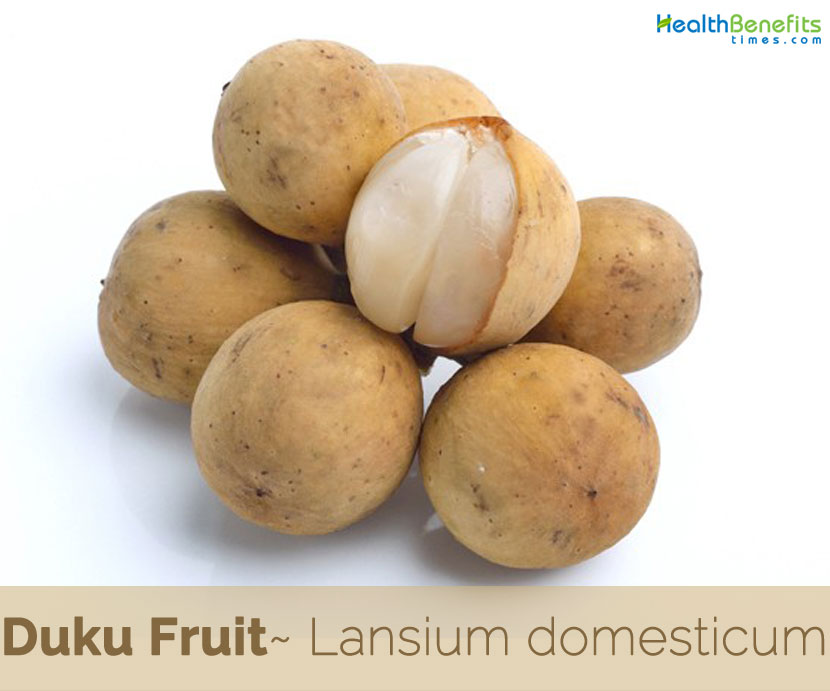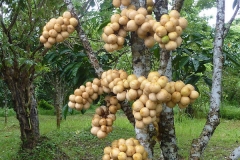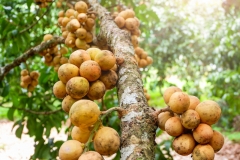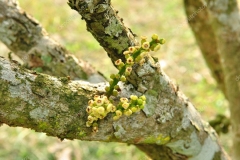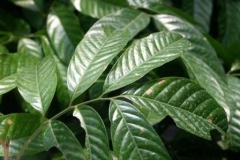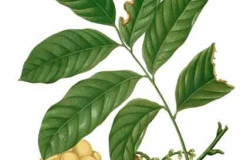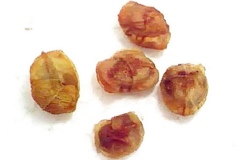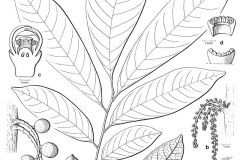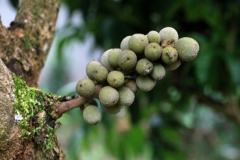| Duku Fruit Quick Facts | |
|---|---|
| Name: | Duku Fruit |
| Scientific Name: | Lansium domesticum |
| Origin | Southeast Asia, throughout the Malay archipelago from Peninsular Thailand, Malaysia and in Indonesia |
| Colors | Dull green ripening to yellow, golden yellow or pale orangey yellow |
| Shapes | Borne 2 to 30 in a cluster, is oval, ovoid-oblong or nearly round, 1 to 2 in (2.5-5 cm) in diameter |
| Flesh colors | Translucent-white |
| Taste | Tangy, sour and sweet |
| Health benefits | Counters Cancer, Prevent Premature Aging, Strengthens Our Teeth and Bones, Good for Digestive System, Maintaining Gum Health, Source of Antioxidant, Improve Immune System, For diabetes, Prevents Malaria, Lose Weight, Cures Worm Infection, Controlling Cholesterol Levels, Relieves migraine attacks, Accelerate recovery, Treating worms, Reduces Fever, Treat diarrhea, Treats Insect and Scorpion Bites, Treats Dysentery, Counters Free Radical, Can be used as Eye Drop, |
| Name | Duku Fruit |
|---|---|
| Scientific Name | Lansium domesticum |
| Native | Indigenous to southeast Asia, throughout the Malay archipelago from Peninsular Thailand, Malaysia and in Indonesia. It is widely cultivated in southern Peninsular Malaysia |
| Common Names | Langsat, Lansa, Lanzon, Lanzone, Lansa, Leang sat, Kokosan, Duku-langsat, Lansones, Boboa, Buahan, Longkong, Bonbon, Bongko, Bongkong, Bijitan, Pitisan, Langsek, Lasak, Lanseh, Ayer-ayer, Bejetlan, Laang-saat, arbol-do-lanza, bòn-bon, duku, duku-langsat, langsat, langsep, lansibaum, lansium, lansones, lanzones, lanzón, longkong, árbol de lanza |
| Name in Other Languages | Bengali: Latka, bhubi Burmese: Langsat, Duku Cebuano: Buahan, lansones Chinese: Lan sa, Lan sa guo, Da Guo Lan Sa Czech: Lansat domácí Danish: Langsat , Langsep, Sød Duku, Doekoe Dutch: Kokosan, Langsep, Langsat, doekoe English: Langsat, Longkong tree, Lansa, Lanzon French: Langsep, Lansium, Duku Doux À Large Fruit, Duku Doux a petit fruit German: Echter Lansabaum, Langsat, Lansabaum, Lansibaum, Süßer Duku, Dukubaum Indonesia: Ceroring, Dookkoo, Duki, Duku, langsat, kokosan Italian: Lansio, Lanzone, Duku Dolce Japanese: Ransa, Duku, Ransatto (ランサット) Javanese: Dhuku Komi: Langsat (Лангсат) Korean: Lang sat, Long Kong Malay: Bidjitan, Ceroring, Kokosan, Langsat, Pidjitan, Pisitan, Pokok Duku, duku-langsat, dookkoo, duki, duku, lansa, langseh, langsep Malayalam: Lānsiyaṁ ḍeāmesṟṟikkaṁ (ലാൻസിയം ഡൊമെസ്റ്റിക്കം) Netherlands: Doekoe Persian: زرگیل Philippines : Duku Polish: Słodliwka pospolita Portuguese: Arbol-do-lanza, Arbol-Do-Duku, Duku-Doce, árvore-do-lansa Russian: Langsat (Лангсат) Sinhalese: Gadu guda Spanish: Arbol de lanza, Lanzón, Lanzones, Arbol De Duku, Duku Dulce, lansones Sundanese: Dukuh, Bijitan Tagalog: Buahan, Lansones, buwa-buwa Thai: Langsat (ลางสาด), Raang saat (รัง สาด), Lasa (ละซะ), Duku, Langsat Waan, longkong (ลองกอง), long gong Ukrainian: Longkong (Лонгконг) Vietnamese: Bòn bon, lòn bon |
| Plant Growth Habit | Erect, short-trunked, average sized, evergreen, slender or spreading tree |
| Growing Climates | Grows well in mixed agro forests, damp, shaded areas |
| Soil | Does best on deep, rich, well-drained, sandy loam or other soils that are slightly acid to neutral and high in organic matter. It is inclined to do poorly on clay that dries and cracks during rainless periods, and is not at all adapted to alkaline soils. It will not endure even a few days of water-logging |
| Plant Size | About 30 meters (98 ft.) in height and 75 centimeters (30 in) in diameter |
| Bark | Mottled grey and orange, furrowed, containing milky, sticky resinous sap; twigs glabrous to pilose |
| Resin | Thick and milk colored |
| Leaf | Pinnate, 9 to 20 in (22.5-50 cm) long, with 5 to 7 alternate leaflets, obovate or elliptic-oblong, pointed at both ends, 2 3/4 to 8 in (7-20 cm) long, slightly leathery, dark-green and glossy on the upper surface, paler and dull beneath, and with prominent midrib |
| Flowering season | April to June |
| Flower | Small, white or pale-yellow, fleshy, mostly bisexual, flowers are home in simple or branched racemes which may be solitary or in hairy clusters on the trunk and oldest branches, at first standing erect and finally pendant, and 4 to 12 in (10-30 cm) in length |
| Fruit Shape & Size | Borne 2 to 30 in a cluster, is oval, ovoid-oblong or nearly round, 1 to 2 in (2.5-5 cm) in diameter, with leathery, glabrous, non-lactiferous, 4–6 mm thick pericarp |
| Fruit Color | Dull green ripening to yellow, golden yellow or pale orangey yellow |
| Skin | Velvety skin, hard, leathery, thin or thick |
| Flesh Color | Thick, translucent-white |
| Seed | Green, relatively large 3/4 to 1 in (2-2.5 cm) long and 1/2 to 3/4 in (1.25-2 cm) wide, very bitter |
| Propagation | By seeds or by budding |
| Taste | Tangy, sour and sweet combination of flavors, and tastes a lot like grapes |
| Season | August and November |
| Health Benefits |
|
Plant Description
Duku Fruit is an erect, short-trunked, average sized, evergreen, slender or spreading tree that usually grows about 30 meters (98 ft.) in height and 75 centimeters (30 in) in diameter. Seedling trees 30 years old planted at 8 x 8 meter spacing can have a height of 10 meters and diameter of 25 cm. The trunk grows in an irregular manner, with its buttress roots showing above ground. The tree’s bark is a greyish color, with light and dark spots. Its resin is thick and milk colored. The plant grows well in mixed agro forests, damp and shaded areas. It does best on deep, rich, well-drained, sandy loam or other soils that are somewhat acid to neutral and high in organic matter. It is inclined to do poorly on clay that dries and cracks during rainless periods, and is not at all adapted to alkaline soils. It cannot tolerate even a few days of water-logging.
Leaves
The pinnately compound leaves are odd numbered, with thin hair, and 6 to 9 buds at intervals. The buds are long and elliptical, approximately 9 to 21 centimeters (3.5 to 8.3 in) long and 5 to 10 centimeters (2.0 to 3.9 in) wide. The upper edge shines, and the leaves themselves have pointed bases and tips. The stems of the buds measure 5 to 12 millimeters (0.20 to 0.47 in). Leaves are slightly leathery, dark-green and glossy on the upper surface, paler and dull beneath, and with prominent midrib.
Flower
Flowers are located in inflorescences that grow and hang from large branches or the trunk; the bunches may number up to 5 in one place. They are often branched at their base, measure 10 to 30 centimeters (3.9 to 11.8 in) in size, and have short fur. The flowers are small, with short stems, and have two genders. Sheathe is shaped like a five lobed cup and is colored a greenish-yellow. The corona is egg-shaped and hard, measuring 2 to 3 millimeters (0.079 to 0.118 in) long and 4 to 5 millimeters (0.16 to 0.20 in) wide. There is one stamen, measuring 2 millimeters (0.079 in) in length. The top of the stamen is round. The pistil is short and thick. Flowering normally takes place from April to June.
Fruits
Duku fruits are small to medium in size, averaging 2 to 7 centimeters (0.79 to 2.76 in) in diameter, and are elliptical, ovoid or round in shape, growing in large clusters of approximately ten fruits. Fruits look much like small potatoes and are borne in clusters similar to grapes. Fruits are initially dull green ripening to yellow, golden yellow or pale orangey yellow as they mature. The thick rind is hard, leathery, and tan to pale yellow, developing brown spots and blemishes as the fruit matures. The rind is also covered in fine hairs giving the fruit a fuzzy appearance. Underneath the surface, there is a white, spongy, and very bitter layer that is easily separated and peeled, and the flesh is thick, translucent-white, and is typically divided into 1-5 segments. These segments are juicy, tender, and soft with a texture similar to grapes, and the flesh may be seedless or contain a few flat and bitter tasting seeds. Fruit are also seedless as they are formed by apomixes. Duku fruits are very sour when young, but as they mature, the fruits develop a sweet-tart flavor with light acidity, reminiscent of grapefruit and Pomelo. It is eaten fresh, made into candies, preserved in syrup, and processed into wine.
Varieties of Duku Fruit
There are two distinct botanical varieties
1) L. domesticum var. pubescens: It is the typical wild langsat which is a rather slender, open tree with hairy branchlets and nearly round, thick-skinned fruits having much milky latex.
2) var. domesticum: Also called the duku, doekoe, or dookoo, which is a more robust tree, broad-topped and densely foliaged with conspicuously-veined leaflets; the fruits, borne few to a cluster, are oblong-ovoid or ellipsoid, with thin, brownish skin, only faintly aromatic and containing little or no milky latex.
Health benefits of Duku fruit
Here are some of the benefits of fruit for health that you should know:
1. Counters Cancer
Langsat, other than its flesh is good for your diet, its skin is also good to cure cancer and is very powerful in preventing the reproduction of cancer cells (just make sure that you clean it very carefully before you eat it). It consists of many nutrition, minerals, fibers, and vitamins which is said to be valuable for treating cancer mostly the ones related with our digestive system.
2. Prevent Premature Aging
Duku fruit is quite beneficial for preventing premature aging. One of the factors causing premature aging is due to free radicals. As mentioned above, vitamin C in this fruit is quite effective to keep the body from free radical attack.
Vitamin C is also useful for protecting lipid proteins, nucleic acids, and carbohydrates from damage caused by free radicals or pollution or toxins.
3. Strengthens Our Teeth and Bones
Langsat fruit consists of vitamin A, also known as retinol or carotenoid, and phosphorus. Vitamin A is actually a vitamin soluble in fats, which plays an important role in maintaining teeth and skeletal bone. Phosphorus too is useful as an agent for bone and teeth formation. Consuming langsat fruit will allow more of these vitamin and mineral to enter your body.
4. Good for Digestive System
Duku fruits consist of very high fiber so it is considered useful for digestion. In addition, this fruit is also nutritious to prevent cancer in the digestive tract. The content of calories, minerals and iron in the fruit is more when compared with apples or sweet oranges.
5. Maintaining Gum Health
Gum health can be treated by consuming vitamin C. As already mentioned that the duku fruit have vitamin C content that helps to maintain healthy gums.
6. Source of Antioxidant
Duku fruit contains the benefits of vitamin C which acts as an antioxidant. Antioxidant itself is a nutrient that works to avoid the body from damage caused by free radicals. This damage is typically caused by a process of digestion that converts food into energy in the body. Antioxidants also play a role to prevent the body from damage caused by pollution and toxic substances.
7. Improve Immune System
Vitamin C is needed for everyone to keep their body healthy. The content of vitamin C in the fruit duku is efficacious to maintain immunity and efficacious also for people who are in the recovery period.
8. For diabetes
This fruit is considered to be a healthy snack for people with diabetes as its high fiber content, along with the presence of the antioxidant polyphenol, aids in improving glucose levels by slowing down the absorption of sugar.
9. Prevents Malaria
We know that extract from chichona plant can help you in preventing malaria especially if you are travelling to tropical areas. Recent research suggests that langsat fruit is a source of compound that works against chloroquine-resistant strains of Plasmodium falciparum one of the protozoa that causes malaria. Extract of langsat fruit disturbs the life cycle of Plasmodium falciparum and are active against a chloroquine-resistant strain of the parasite.
10. Lose Weight
Duku fruit is not supposed that it can also be used to lose weight. Duku fruit will help the body to get carnitine. Carnitine will direct the fat molecule to a fat-burning tissue. These fat molecules should be considered for anyone who is losing weight because if there is a lack of fat molecules, the body will feel tired and lack of energy.
So, if the carnitine in the body decreases fat accumulation will occur. Duku fruit can also be consumed along with the benefits of apples for those who are undergoing a diet program.
11. Cures Worm Infection
If your child suffers from intestinal worm infection, langsat seeds are effective in treating the child’s intestinal worm infection. These herbal methods are easier to be done and are safer to be used regularly compared to drug based worm treatment. Again, you should serve the seed in a mixture of crushed seed with water as suggested above to gain the maximum benefit of the treatment.
12. Maintain Skin Health
Skin health can be maintained by frequently consuming foods that contain vitamin E benefits. Duku fruit also consists of good amount of vitamin E so it is effective to maintain skin health such as prevent premature aging, softens and softens the skin, keep skin moist, keep skin from UV rays and helps heal wounds.
13. Controlling Cholesterol Levels
Metabolism of cholesterol in the body will become bile acids. For people with cholesterol disease, this can be helped by frequent consumption of duku fruit.
14. Relieves migraine attacks
Several research has revealed the positive impact of riboflavin (Vitamin B2) in minimizing and combating a migraine attack, this fruit (containing a considerable amount of this vitamin) may be included in the list of foods migraine sufferers can add to their diet to reduce the chances of an attack.
15. Accelerate recovery
The content of vitamin C in Duku fruit was able to speed up the recovery process for those who are sick. This is because vitamin C is an active antioxidant that can restore bodily functions. However, duku is not the best fruit for this problem. If it is in the process of recovery, it is recommended to consume grapefruit, papaya, apples or bananas.
16. Treating worms
Children are very vulnerable to the worm because it does not understand very well about cleanliness. Also forbidden dilemma due to play in the soil is a very reasonable thing to develop a child’s motor nerves. If your child has symptoms of worms, such as lackluster, pale, weight loss and frequent scratching the anus, you should immediately treat it. Guanka duku resolve the issue. Take seeds of duku, and crunch finely until ground. Mix with 1/4 cup water and drink 2 times a day.
17. Reduces Fever
Additional to the various nutrition that are in langsat fruit flesh, other parts of langsat fruit can also be used. It seeds has been known to be able to reduce fever. Generally, you don’t want to eat seeds because it taste bitter, but in cases where you need to we recommend you to crush them thoroughly first that way the nutrients are extracted most and brew it with hot water. To crush the langsat seeds, you need to dry them first. Once the seeds are dry enough to be roasted, crush the seeds. After that, brew the crushed langsat seeds with warm water.
18. Treat diarrhea
Diarrhea in children is caused by consuming foods that are spicy or less than clean. But you need not worry because the duku seeds can treat diarrhea. Powdered duku seeds are mixed with 1/4 cup of water and drink.
20. Treats Insect and Scorpion Bites
Whether you are in the middle of a trip in the wild and get bitten by insects or even a scorpion or just hanging around your house. Langsat tree particularly the bark can be used as medicine to treat insect bites or scorpion bites. To use the bark of fruit: start by taking the starch stored in the tree bark. Starch is then applied to the part bitten by insects or scorpions and left to dry up. Perform this treatment process several times until the bite wound is no longer swollen and completely cured.
21. Treats Dysentery
Research have lately shown that langsat tree bark extract is useful in treating dysentery disease, there is also a lot of local cultures that uses langsat tree to treat dysentery.
22. Counters Free Radical
We have discussed before about how langsat fruit can help prevent cancer especially digestive related cancer such as colon cancer. Langsat fruit has the ability to repel free radicals in the body. Free radical can lead to destruction in cell DNA which leads to failure of cell reproduction. This leads to a lot of chronic diseases. By eating langsat fruit, we will also be kept away from these other diseases caused by free radicals that may be prowling for our health.
23. Can be used as Eye Drop
Have something that irritates your eyes but don’t have an eye drop? Langsat fruit extracts can help replace the need for an eye drop. Langsat fruit leaves can be combined with langsat tree’s bark then brewed. Once the liquid is obtained, it can be used as an eye drop for inflammatory in the eye.
Duku Benefits for Beauty
In addition to health and medicine, the benefits duku could also be felt in the world of beauty. Among them help eliminate acne, nail care and maintain hair’s natural moisture.
Eliminate Acne
Lots of fruits have been used as a natural acne cure. Starting from lime, papaya, tomato and lemon, Duku also have the same ability, though not as powerful fruits that have been mentioned above.
Keep the hair’s natural moisture
Duku also can keep the hair’s natural moisture from within, thanks to their nutritional content. But you also can perform maintenance on the outside with manjadikannya as a natural mask for the hair. In addition to keeping the humidity, also prevents hair loss, and nourish hair.
Traditional uses and benefits of Duku Fruit
- In traditional medicine, the bark is considered astringent and its decoction has been used for dysentery in Java, Borneo, and Malaya.
- Decoction of the bark and leaves has been used in the treatment of dysentery and Malaria.
- Powdered bark is used as a poultice therapy for scorpion stings.
- Wood tar has been used for blackening teeth.
- Sap from the leaves has been used as eye drop for sore eyes.
- Juice of the bark and fruit skin is recorded as a Dyak arrow poison.
- Bitter seeds, ground and mixed with water, were given to children against worm.
- Bitter seeds, crushed, were used to cure fevers among the Sakai in Peninsular Malaysia.
- Resin from bark was recommended for flatulence, for swellings and as an antispasmodic and was also deemed useful in the treatment of inflammation and colic of the gastro-intestinal tract.
- Tincture prepared from the dried rind, was also useful, as an anti-diarrheic or anti-colic.
- Resin is non-toxic and used against diarrhea and intestinal spasms.
- Dried pericarp is used in the treatment of diarrhea, malaria, and fever.
- Dried peel is burned to repel mosquitoes and as incense.
- Resin is non-toxic and administered to halt diarrhea and intestinal spasms.
- Pulverized seed is used as a febrifuge and vermifuge.
- The leaf juice is used as eye-drops to dispel inflammation.
- Pounded seeds are added to water to be drunk as a medication for ulcer and deworming.
- Powdered bark is used as a poultice to treat scorpion stings.
Culinary Uses
- Thick, sweet, weakly aromatic aril of ripe fruit is eaten fresh and can be preserved in syrup.
- It is eaten fresh, made into candies, preserved in syrup, and processed into wine.
- Fruit can be consumed raw or cooked.
- Seeds can sometimes cling very tightly to the flesh and can then impart their bitterness to the fruit.
- Peel of the langsat is easily removed and the flesh is commonly eaten out-of-hand or served as dessert, and may be cooked in various ways.
- The peeled, seedless or seeded fruits are canned in syrup or sometimes candied.
Other facts
- Light brown wood is durable and used for house posts, tool handles, rafters and small utensils.
- The plant is not tolerant to drought, slow-growing, and shallow-rooted.
- The tree is used in reforestation of hilly areas.
- The peel is reportedly high in tannin.
- Wood tar, derived by distillation, is used to blacken the teeth.
- The wood is light-brown, medium-hard, fine-grained, tough, elastic and durable, weighing 840 kg/ cu m.
- This fruit was regarded to be poisonous and got its name from the Filipino word lason (meaning poison).
- Traditionally in the Philippines, dried skin of lanzones was burnt and used as a katol (repellant) to drive away mosquitoes and also as incense sticks to add aroma in rooms of sick people.
- Trees in the Nilgiris average 30 lbs. (13.5 kg) of fruits annually.
- In the Philippines, a productive tree averages 1,000 fruits per year.
- It is the provincial flower for the Indonesian province of South Sumatra.
Precautions
- An arrow poison is made from the fruit peel and the bark of the tree.
- Eating raw fruits is undesirable as it contains tannins, and therefore causes bitterly astringent effect on the tongue, palates and throat.
- Chewing langsat seeds can cause bitter aftertaste and unpleasant sensation.
- People with diabetes need to avoid eating too much of them at one go because of their high sugar content.
- Over-consumption might affect your health adversely as it is one of the fruits known to cause gas and bloating.
References:
https://www.itis.gov/servlet/SingleRpt/SingleRpt?search_topic=TSN&search_value=506421#null
https://npgsweb.ars-grin.gov/gringlobal/taxonomydetail.aspx?id=70393
https://pfaf.org/user/Plant.aspx?LatinName=Lansium+domesticum
https://plants.usda.gov/core/profile?symbol=LADO2
https://www.cabi.org/isc/datasheet/29802
https://www.wikidata.org/wiki/Q860731
https://gd.eppo.int/taxon/LNIDO
http://www.theplantlist.org/tpl/record/kew-2494250
http://tropical.theferns.info/viewtropical.php?id=Lansium+domesticum
http://www.plantlives.com/docs/L/Lansium_domesticum.pdf
https://hort.purdue.edu/newcrop/morton/langsat.html
https://uses.plantnet-project.org/en/Lansium_domesticum_(PROSEA)
http://www.stuartxchange.org/Lansones.html


